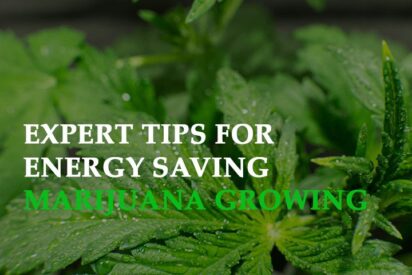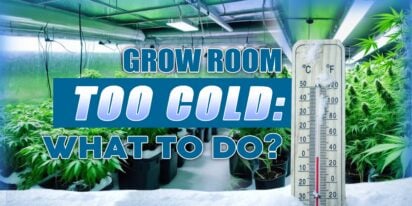
Are You 18 Or Over?
YesOr
No By clicking yes, you certify that you are over 18. By using this website, you agree to our legal disclaimer.605+ Cannabis Strains over 20 Breeders worldwide.
Table of Contents

You’ve heard of the many names of marijuana. And the names seem to be endless. That only means that the production of marijuana increases as the consumer demands a more customized strain. With increased competition, prices also went down. In one of the states in the USA, a pound of hash was sold for $750 in 2017 and went down to $500 by the end of 2018.
To stay afloat, producers now have to tighten bolts, particularly regarding their energy costs, as these partake 20 to 40% of the final product’s cost. They turn to the efficient use of energy to help the business maintain revenue. This article will discuss energy-saving marijuana growing and some helpful tips on saving energy. Let’s start the Go Green Journey.
Here are some shocking facts (for non-breeders) regarding the use of energy resources in growing marijuana.
· Indoor systems use fans and lights mostly on a 24/7 operation.
· Some places (where cannabis is legalized) experience blackouts traced to marijuana production facilities.
· Indoor commercial cannabis production (AKA cannabis grow room) can consume 2,000 to 3,000 kilowatt-hours (kWh) of energy per pound of product.
The amount of energy used for breeding our beloved plant is overwhelming. The next three sections will talk about the impact and costs on the energy sector and the culprit and reason for intensive use.
As you can grow your own pot (if cannabis is legal in your state that is), you are still limited to a specific number of cannabis plants for personal use. When you start propagating marijuana, you will be part of the 1% of electricity consumed in the USA by cannabis breeders. In some markets where marijuana was legalized on an earlier date, growers use up to 4% of the state’s electricity. That’s why many utility companies are now actively collaborating with commercial growers to identify energy efficiency measures. Legislatures also are placing restrictions on the types of lighting that growers can install in some states.
If you live, let’s say in Massachusetts, the average commercial/business price per kilowatt-hour is 16.14 cents. A maximum of 3,000 kWh will cost you $484. An ounce of marijuana will cost you about $340. If you convert to pounds, that will generate around $5,440 in retail revenue. So to grow, one pound of the hash will be equal to paying $484 for 3,000 kWh generating $5,440 in retail revenue. That’s a biggie on the electric bill and on the budget.
In the operation of a marijuana grow room, electricity is used for lighting, ventilation, exhaust fans, cooling or heating system, and water systems. Ventilation, cooling, and humidifying systems are the culprits with lighting as an accomplice. The rest have just minor roles to play.
Outdoor farms are not energy exhausting, unlike indoor growing operations. However, growing marijuana indoors is more controllable than the unpredictable setting in the outdoors.
Growing Cannabis is energy extensive because light and air are essential in the optimal growth of a plant. Light is needed for photosynthesis for the plant to create its own food from air and water. Due to the strict temperature and humidity needs of the plants, growers invest costly in air conditioning, ventilation, and humidification. Humidity must be kept at 70 percent and lessened to 50 percent during the flowering stage.
The intensive use of energy in growing marijuana calls for energy-saving tips from the experts that can help you conserve precious energy. Here are more than a handful of them:
1. Find the appropriate size for your grows
If you are using cannabis for personal use, then you may choose for a smaller sized grow room. But, if you are a licensed commercial grower, then take into consideration the type of strain, the amount it yields, and how much effort you will put in propagating and marketing your cannabis bud.
2. Take your plants outside
The outdoors can be great for the plant since it will receive natural sunlight. Your indoor growing equipment can also take a break by exposing the plant outside. Be sure, though, that you have the proper enclosure that is away from public view.
3. Buy efficient lighting equipment
The traditional high-pressure sodium light has a high wattage and runs hot that you have to increase coldness in your room by increasing air conditioning. LED grow lights last longer, run cooler, and use about half the energy of traditional grow lights. There are a lot of LED grow lights in the market that differs in quality and energy use. Additionally, some offer rebates for low-energy LEDs that are top quality for the indoors.
You can also try compact fluorescent lamps or CFL lights during daylight. CFL during the vegetative stage, along with sunlight, will cut your costs and give you better buds.
4. Put insulation around your grow space
Growers unknowingly overuse their heaters, cooling equipment, and humidifier because they’re preventing outdoor air from entering their growing space. Leaks also allow indoor air to escape. The solution to this is to air seal and insulate. Air sealing and insulation projects are done by a Home Performance with ENERGY STAR® contractor.
5. Upgrade on your cooling and heating equipment
Traditional HVAC systems bring in outdoor air to save on cooling the ambient air. This isn’t ideal for cannabis growers as it can also mean introducing pests and contaminants that cause mildew and disease. The revolutionized cold-climate heat pumps deliver cooling and heating with little energy use.
Larger growers (with more than 6,000 square feet of canopy) may find it more cost-friendly with a chilled water system. In this system, chilled water circulates and removes heat from the building before returning to a chiller to cool again. You can slow the fan speed and reduce the water temperature for better heat removal, without a separate dehumidifier.
6. Install an efficient humidifier
Growers use humidifiers to prevent mold. Be sure to get the smallest model in proportion to your grow space to avoid unnecessary energy use.
7. Stay Clear of Auto-Flowering Strains
When grown indoors, they require 18 or more hours of light per day, depending on the size of your grow. The feminized strains only require 12 hours of light. Try moving your plants outside so they can soak up some natural light too.
8. Go for the Screen of Green Method
The best way to maximize the amount of light your plants are getting without leaving them in the light for longer is by using SCROG. A screen is placed above the plants to anchor the plants as they are spaced out evenly to the canopy. This allows more light to reach lower tiers and will surely make the plants healthier and the electric bill lower.
9. Learn more about Cannabis Energy Efficiency Incentives
Many utilities have developed energy efficiency programs to collaborate with cannabis grow operations. Here are some:
· Excel Energy (Colorado and Michigan)
· National Grid (Massachusetts).
· Pugent Sound Energy (Washington)
· Sacramento Municipal Utility District (California)
They have programs such as rebate and incentive programs for HVAC and lighting upgrades.
If you are a licensed commercial cultivator, your local utility company is bound by law to service your account. You are entitled to enjoy and take part in any of the incentive programs your utility offers.
10. If you have enough budget, you can rent out the STEM box.
Licensed growers can rent the STEM box and grow plants in them. A STEM box is a prebuilt modular grow system. It uses science, technology, engineering, and math to create pot the most energy-efficient way.
It is a vertical, self-contained, hydroponic pot farm. Roots are mounted in 24 plastic columns that slide in and out for harvesting. They are automatically fed precise amounts of water and nutrients. A 5-ton air-conditioning system keeps 240 plants happy. The state-of-the-art bright LED lights are powerful and positioned just right to maximize plant canopy exposure.
11. Growers embrace the Internet of Things for energy efficiency
More cultivators are installing internet-of-things (IOT) technologies in greenhouses to optimize the use of power, water, and nutrients.
Tech-savvy growers are going to build greenhouses with sensors to track variables such as heat and humidity. It is used to assess growing conditions throughout the facility and to reduce wastage of raw materials such as energy and water.
The level of environmental control is equal to the most advanced building management systems found in the commercial and industrial power sectors. It also gives a more granular picture of the greenhouse environment, allowing growers to recognize the presence of localized microclimates that could affect cannabis yield.
12. Growers might opt to use microgrids to cut energy bills
Combining solar energy with battery storage and co-generation plants is what microgrid is all about. Sadly, funding a microgrid installation is a problem for most growers. It would cost $3 million or more to install a microgrid. Banks would also be hesitant to lend money to businesses that are operating outside of federal law.
To overcome this problem, a company is working with niche investors to offer microgrids with a full finance package. Let’s just wait and see if the technology would be worth all that money.
From the mouth of the experienced growers to the eyes of the novices, the tips are “gold” when wisely used and not just read. We need a constant reminder to conserve energy not only as a cannabis grower but as a steward of the earth.

In recent years, the discourse surrounding secondhand marijuana smoke has gained significant attention, paralleling the legalization and increas

In the realm of cannabis culture, the practice of "wake and bake" holds a significant place, accompanied by both supporters and skeptics. As exp

Introducing the robust indica strain known as Critical Mass weed, a harmonious fusion of Afghani and Skunk #1 genetics. Delve into its essence,

Fusarium wilt cannabis represents a significant threat to cannabis cultivation, necessitating a comprehensive understanding of its intricacies.

1980s were a time of profound cultural transformation, marked by iconic fashion, music, and movies. Alongside these trends, a unique facet of '8

[ez-toc] In the deep history of cannabis cultivation, there exists a captivating and creative practice that combines the art of cultivation wit

For growers looking to get better yields and healthier cannabis plants, it's important to understand and control the cannabis soil pH levels. pH

[ez-toc] In indoor gardening, maintaining an optimal temperature within your grow tent is crucial for the health and productivity of your plant

[ez-toc] Welcome to the delightful world of cannafudge crafting, where sweetness meets sophistication, and cannabis infusion adds a unique twis

[ez-toc] You’ve finished trimming your weed, but what about those leftover stems? Don’t throw them away! These seemingly useless bits can a

Are You 18 Or Over?
YesOr
No By clicking yes, you certify that you are over 18. By using this website, you agree to our legal disclaimer.